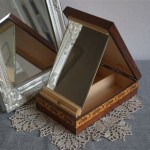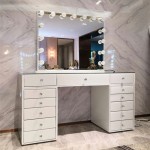Tilting Wall Mirror Brackets: A Comprehensive Guide
Tilting wall mirror brackets are specialized hardware components designed to securely mount mirrors to walls while allowing for adjustable viewing angles. These brackets offer a practical and aesthetic solution for various applications, from bathrooms and dressing rooms to commercial spaces like retail stores and gyms. Their adjustability caters to users of different heights and viewing preferences, enhancing the functionality and usability of the mirror.
The fundamental purpose of tilting mirror brackets is to provide a secure and adjustable mounting system. Unlike fixed mirror mounts, these brackets allow the mirror to be tilted upwards or downwards, enabling users to customize the viewing angle for optimal visibility. This adjustability is particularly beneficial in situations where the mirror is used by multiple people with varying heights or in spaces where lighting conditions necessitate angle adjustments to minimize glare or enhance reflection.
Furthermore, tilting mirror brackets can contribute to the overall design aesthetic of a space. They are available in a variety of styles, finishes, and materials, allowing them to blend seamlessly with different interior design schemes. The brackets themselves can become a visual element, adding a touch of sophistication or industrial flair, depending on the chosen design.
Understanding the Mechanics of Tilting Mirror Brackets
The core mechanism of tilting wall mirror brackets revolves around a pivot point or hinge system. This system allows the mirror to rotate vertically, typically within a defined range. The design of the pivot point varies depending on the specific bracket model, with some utilizing friction hinges for smooth and controlled tilting, while others employ locking mechanisms to secure the mirror at a desired angle.
Friction hinges offer a seamless tilting experience, allowing users to adjust the mirror angle with minimal effort. The amount of friction can often be adjusted to suit the weight of the mirror, ensuring that it remains stable at the chosen angle without slipping. Locking mechanisms, on the other hand, provide a more secure fixation, preventing accidental movement and ensuring that the mirror remains firmly in place until manually adjusted.
The construction of the bracket typically involves two main components: a wall-mounted bracket and a mirror-mounted bracket. The wall-mounted bracket is securely attached to the wall using screws and anchors, while the mirror-mounted bracket is affixed to the back of the mirror. These two brackets are then connected via the pivoting mechanism, allowing the mirror to be tilted. The quality of the materials and construction of these components directly impacts the durability and stability of the entire system.
The tilting range is another crucial aspect of the bracket design. This refers to the maximum angle to which the mirror can be tilted upwards or downwards. The ideal tilting range depends on the intended application and user preferences. For instance, a bathroom mirror might require a smaller tilting range than a full-length dressing room mirror used by individuals with significant height differences.
The weight capacity of the bracket is a critical consideration when selecting a tilting mirror bracket. Exceeding the weight capacity can lead to bracket failure, potentially causing the mirror to fall and resulting in damage or injury. It is essential to carefully assess the weight of the mirror and choose a bracket with a sufficient weight rating to ensure safe and reliable installation.
Factors to Consider When Choosing Tilting Wall Mirror Brackets
Selecting the appropriate tilting wall mirror brackets necessitates careful consideration of several factors, including the mirror's size and weight, the desired tilting range, the mounting surface characteristics, and the overall aesthetic preferences. Ignoring these factors can lead to unsatisfactory results or even safety hazards.
The size and weight of the mirror are paramount in determining the appropriate bracket size and weight capacity. Larger and heavier mirrors require more robust brackets with higher weight ratings. It is advisable to consult the manufacturer's specifications and guidelines to ensure compatibility between the mirror and the bracket. Measuring the mirror accurately and estimating its weight are crucial first steps in the selection process.
The desired tilting range should align with the intended application and the needs of the users. Consider the height range of the individuals who will be using the mirror and the specific tasks they will be performing. For example, if the mirror is intended for applying makeup, a narrower tilting range might suffice, whereas a mirror used for dressing may require a wider range to accommodate different viewing angles.
The mounting surface characteristics play a significant role in bracket selection. Different wall types, such as drywall, plaster, concrete, or tile, require different types of anchors and fasteners. Ensure that the chosen brackets are compatible with the wall type and that appropriate mounting hardware is used for secure installation. Consulting with a professional installer is recommended for complex or unusual wall types.
Aesthetic considerations should not be overlooked. Tilting mirror brackets are available in a variety of styles, finishes, and materials, ranging from sleek and modern to ornate and traditional. Choose brackets that complement the overall design aesthetic of the space and the style of the mirror. Consider the finish of the brackets and how it will coordinate with other hardware and fixtures in the room. The visual appeal of the brackets can enhance the overall look and feel of the space.
The material of the bracket also contributes to its durability and appearance. Common materials include stainless steel, brass, aluminum, and various alloys. Stainless steel is known for its corrosion resistance and longevity, making it a suitable choice for bathrooms and other humid environments. Brass offers a classic and elegant look, while aluminum provides a lightweight and durable option. The choice of material should be based on the desired aesthetic, the environmental conditions, and the budget.
Installation and Maintenance of Tilting Wall Mirror Brackets
Proper installation is crucial for ensuring the safety and functionality of tilting wall mirror brackets. Incorrect installation can lead to bracket failure, mirror damage, or even personal injury. Therefore, it is essential to follow the manufacturer's instructions carefully and to utilize appropriate tools and hardware.
Before commencing the installation process, carefully read and understand the manufacturer's instructions. Gather all necessary tools and materials, including a drill, screwdriver, level, measuring tape, pencil, and appropriate wall anchors and screws. Ensure that the wall is clean and free from obstructions before marking the mounting locations.
Accurately mark the mounting locations on the wall using a level and measuring tape. Ensure that the brackets are aligned correctly and that the mirror will be positioned at the desired height. Drill pilot holes at the marked locations and insert appropriate wall anchors if necessary. Securely attach the wall-mounted brackets to the wall using screws.
Attach the mirror-mounted brackets to the back of the mirror, following the manufacturer's instructions. Ensure that the brackets are properly aligned and securely fastened to the mirror. Carefully lift the mirror and attach it to the wall-mounted brackets, ensuring that the pivoting mechanism is correctly engaged.
Once the mirror is installed, test the tilting mechanism to ensure that it operates smoothly and that the mirror can be adjusted to the desired angles. Tighten any loose screws or adjust the friction hinges as needed to achieve the desired stability and tilting range. Inspect the installation to ensure that all components are securely fastened and that the mirror is stable and safe.
Regular maintenance is essential for prolonging the lifespan of tilting wall mirror brackets and ensuring their continued functionality. Periodically inspect the brackets for any signs of wear, corrosion, or looseness. Tighten any loose screws and lubricate the pivoting mechanism as needed to maintain smooth operation. Clean the brackets with a soft cloth and mild detergent to remove dust and grime.
Avoid using harsh chemicals or abrasive cleaners, as these can damage the finish of the brackets. If the brackets are exposed to moisture, such as in a bathroom, wipe them down regularly to prevent corrosion. By performing regular maintenance, you can ensure that your tilting wall mirror brackets remain in good condition and provide reliable service for many years.

Asi 0600t Adjustable Tilt Mirror Left And Right Brackets 0600 T

Square Black Pivot Mirror Hardware Tilting Anchors Hamilton Hills

Hawthorn Hill Deco Square Tilting Bathroom Mirror With Metal Frame 508h X 508w 618w Incl Brackets The English Tapware Company

Round Broe Pivot Mirror Hardware Tilting Anchors Hamilton Hills

Afina Rm 926 Sn T Radiance Double Arch Frameless Wall Mirror With Decorative Tilt Mounting Brackets Qualitybath Com

Hamilton Hills 24 X 36 Frameless Pivot Mirror With Round Polished Chrome Wall Brackets Target

L Brackets Surface Mounted

Andy Star 34 Inch Tall By 22 Wide Rectangular Tilting Modern Floating Vanity Mirror With Rounded Edges And Adjustable Wall Mounts Brushed Nickel Target

Afina Rm 630 P Sn T Pivot Bathroom Mirror Wall Mounted Tilting

Hawthorn Hill Deco Round Tilting Bathroom Mirror With Metal Frame 533 Dia 643w Incl Brackets The English Tapware Company







